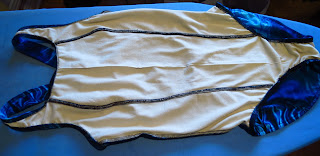 Wow, I've been MIA for the entire month of December! Some of this is due to necessarily secretive pre-Christmas sewing. Which really wouldn't excite you anyway, consisting mainly of pajamas. One example at right. I did well in my annual quest for unusual/loud/surprising prints with this urban scene. Notice the contrast piping on the collar. It's repeated on the pocket and cuffs.
Wow, I've been MIA for the entire month of December! Some of this is due to necessarily secretive pre-Christmas sewing. Which really wouldn't excite you anyway, consisting mainly of pajamas. One example at right. I did well in my annual quest for unusual/loud/surprising prints with this urban scene. Notice the contrast piping on the collar. It's repeated on the pocket and cuffs.  |
| Vonica |
 |
| Why yes, that is a kid-sized Chicago Blackhawks hockey jersey ... |
I'll take some more pics soon, maybe even with the skirt they are supposed to coordinate with. When it is more than a muslin, that is.
 In the meantime, here is the back of the top. For some reason, this is the only picture that survived unscathed.
In the meantime, here is the back of the top. For some reason, this is the only picture that survived unscathed. If you're a very dedicated follower of patterns, you may be able to tell that this is Jalie 2682. The fabric is an extremely stretchy wool and lycra jersey purchased many years ago at a knitting mill in downtown Hamilton Ontario. A friend knew about weekly sales of seconds, and I snapped this up for (if memory serves) about $2 per 1.5 metre piece. Two pieces made the sleeveless top and a coordinating waterfall cardigan. The atmosphere of the place was positively Dickensian and I wonder if it could possibly have survived. If anyone knows, leave me a comment.

I didn't have enough fabric to double the front, so I finished the neck edge and armscyes with the world-famous Jalie no-elastic trim finish. This time I put the binding on the inside, like a facing, and topstitched it. Looks just great, and as always it produces a firm and beautifully finished edge.
The delightful skirt I'm wearing with my new top is the second muslin of Vogue 1324. For fun I thought I'd show you how the first muslin compares.
 |
| Before |
 |
| After |
There are not too many reviews of this pattern as made up, but every one I've seen has had this tell-tale pooching at approximately crotch level in the front. It's not a great look, IMHO.
While the skirt is overall too tight, the main problem in the front is that there is too much length from waist to hip level in the CF piece, and there is too much width caught in the darts, which release just where the pooching is at its max, making it all so much worse. I showed you the fix in this post.
The post-alteration front is smoother through the tummy. I think once it's made up in my cashmere fabric (yummy) it will lie smooth and flat. Or maybe I'm self-deluding.
 |
| Before |
 |
| After |
The arrow on the other side is pointing to the folds caused by too much length in front.
My adjustments add width through the thigh, making the skirt more wearable. However, now that the skirt can fall from the waistband, other problems appear. The back is also too long. See how it's pulling diagonally at the upper side, drooping under my seat, and hitting the back of my knees at the hem? If I scoop about 1.5cm off the waist seam at CB, tapering to the original point where the side seam would be, it should take care of these problems.
So I hear you thinking that I've taken all the interesting bits out of this and turned it into a ho-hum pencil skirt that looks like every other pencil skirt in the universe. I assure you, it's still slim fitting and plenty interesting with those curved seams. I've just altered it into the wearability range, for The Sewing Lawyer. Besides, it will be orange cashmere when I've finished.










.jpg)
.jpg)
.jpg)




















